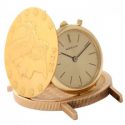I remember my grandfather had one of those odd-looking antique watches. I was about 5-years-old when he showed it to me. It was round, silver, heavy and had a chain on it. He told me it was called a “pocket watch,” and I was skeptical. Was he pulling my leg? He flipped the lid up to reveal the clock beneath, and unlike the digital wristwatches around at the time, this one had a bunch of “X’s” and “I’s.” How in the world did grandpa know what time it was by looking at “X’s” and “I’s?”

Now that I’m older and wiser, I can read Roman numerals, and I can truly appreciate the fine quality of grandpa’s watch. He had saved his watch from the 1910s, when he was a teenager. After the First World War, wristwatches replaced pocket watches as the bestsellers in stores. Soldiers in the war needed both hands free, and wristwatches allowed that.
Today, if you take out an antique watch at a party, you’re sure to start people talking because it’s unexpected and unique. A classic pocket watch gives you an air of sophistication, and tells people you appreciate novel, historic, well-made things. I think I’ll ask my grandpa to borrow his old pocket watch for an upcoming dinner party I’m attending.
If a pocket watch isn’t your thing, perhaps because you crave practicality over standing out in a crowd, consider trying on some antique wristwatches from the 1950s-1970s. You don’t want cheap quartz watches with their logos worn off. And avoid watches from the 1960s and 1970s with less than 17 jewels, because they’re not high-quality. When you decide to own or wear an antique watch you’re distinguishing yourself from the norm, and it’s good to treat yourself to the best.
Classic names to look for include: Benrus, Hamilton, Bulova, Omega, Gubelin, Girard Perregaux and Gruen. You can find antique watches on eBay.com, at estate sales, and through Frank Pollak & Sons in New York City. Good luck in finding a unique timepiece that your grandkids will someday be admiring.

